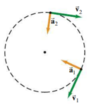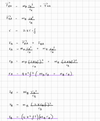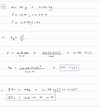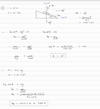Module 03: Motion and Gravitation Flashcards
(87 cards)
Lesson 3.1: Uniform Circular Motion
What is uniform circular motion?
An object that moves in a circle at a constant speed (v)
- Magnitude of the velocity remains constant
- Direction of the velocity continuously changes as it goes around a circle
Lesson 3.1: Uniform Circular Motion
Describe acceleration in a uniform circular motion:
Constantly accelerating:
- Defined as the rate of change of velocity, a change in direction of velocity is an acceleration, just like a change in magnitude.
- Constantly accelerating even when speed is constant
Lesson 3.1: Uniform Circular Motion
How do you calculate acceleration in Uniform Circular Motion (when t != 0)?

Lesson 3.1: Uniform Circular Motion
What is Centripetal (Radial) Acceleration?
🔬 Centripetal (Radial) Acceleration: (aR)Directed along the radius, towards the centre of the circle
When ∆t is very small (approaching zero):
- ∆l and ∆Θ are also very small
- v2 will be almost parallel to v1 & ∆v will be essentially perpendicular to them (towards the centre of the circle)
Lesson 3.1: Uniform Circular Motion
How do you calculate the magnitude of radial acceleration?

Lesson 3.1: Uniform Circular Motion
What is the formula to determine radial acceleration?

Lesson 3.1: Uniform Circular Motion
How does velocity change depending on speed and radius?
(1) Greater the speed (v) - the faster the velocity changes direction
(2) Larger the radius - the less rapidly the velocity changes direction
Lesson 3.1: Uniform Circular Motion
Describe the acceleration and velocity vectors of uniform circular motion:
- Acceleration vector points towards the center of the circle (v is constant)
- Velocity vector points in the direction of motion (Tangential to the circle)
Perpendicular to each other

Lesson 3.1: Uniform Circular Motion
What are frequencies and periods in a circular motion and how does it relate to speed?
Circular motion described in terms of …
- Frequency (f): number of revolutions per second
- Period (T): time required to complete one revolution
Relationship: T = 1/f
Speed travels a distance 2πr in one revolution:

Lesson 3.1: Uniform Circular Motion
What is centripetal force and how is it calculated?
(According to Newton’s Second Law [ΣF = ma]) a net force is necessary to give it centripetal acceleration
Calculate the magnitude needed where ΣFR = maR and where aR = v2/r:
ΣFR=maR=m(v2/r)
Net force directed towards the centre of the circle - called centripetal force
Lesson 3.1: Uniform Circular Motion
What are the problem-solving steps to solve uniform circular motion questions?
1. Draw a FBD: show all forces (tension in a cord, gravity from Earth, normal force, friction) but not something that doesn’t belong (like centrifugal force)
-
Determine which forces act to provide the centripetal acceleration. The component that acts radially, towards or away from the centre of the circular path.
Sum of these forces provides the centripetal acceleration: aR = v2/r - Choose a convenient coordinate system
- Apply Newton’s second law to the radial component: ΣFR=maR=m(v2/r)
Lesson 3.1: Uniform Circular Motion
Describe what happens when a car traveled around a curve?
- Feels like you are thrust outwards towards the right side door
- You move in a straight line, whereas the car moves in a curved path
- To make you go in the curved path, the seat (friction) and door of the car (direct contact) exert force on you
- The car also has a force exerted on it towards the centre of the curve if it is to move that curve

Lesson 3.1: Uniform Circular Motion
What friction applies when a car is breaking?
- Wheels travel without slipping or sliding, the bottom of the tires rest against the road The friction force the road exerts is static
- If static friction is less than mv2/r and the car skid out of control = friction force becomes kinetic friction (smaller than static friction)
- Worse when the wheels lock: (when rolling, static friction exists) tires slide and friction force (kinetic) is less
- The direction also changes:
Static friction can point perpendicular to the velocity
The force no longer points towards the centre of the circle, and car continues in a curved path
Lesson 3.1: Uniform Circular Motion
How do banked curves help reduce the chance of skidding?
- Normal force exerted by a banked road (perpendicular to the road) will have a component towards the centre of the circle - reducing friction
- Given banking angle Θ, one speed for which no friction at all is required
- When the horizontal component of the normal force towards the centre of the curve, FNsinΘ = to the force required to give the vehicle its centripetal acceleration:

FNsinΘ = mv2/r
Lesson 3.2: Law of Universal Gravitation
Describe the centripetal acceleration of the moon due to the Earth’s gravity:

Lesson 3.2: Law of Universal Gravitation
How is the gravitational force related to the distance from Earth’s centre?

Lesson 3.2: Law of Universal Gravitation
How does gravity relate to distance and the mass of an object?

Lesson 3.2: Law of Universal Gravitation
What is the Law of Universal Gravitation?
🔬 Law of Universal Gravitation: Every particle in the universe attracts every other particle with a force that is proportional to the product of their masses and inversely proportional to the square of the distance between them.
Magnitude of Gravitational Force:
- m1 and m2 are masses, r is the distance, and G is the universal constant (measured experimentally)
- G = 6.67 * 10-11 N*m2/kg2

Lesson 3.2: Law of Universal Gravitation
How can you determine the Force of Gravity on an Object on the Earth’s Surface?

How are satellites put into orbit?
- Put into orbit by accelerating it to a sufficiently high tangential speed
- If its too high, it will escape
- If its too low, it will return to earth
- Put into circular motion - because it requires the least takeoff speed
How are satellites kept in space by their high speed?
Satellite in orbit is falling (accelerating) towards Earth, but its high tangential speed keeps it from hitting Earth
Needed acceleration = v2/r
Newton’s law of universal gravitation: (Apply Newton’s second law ΣFR = maR in the radial direction)
- Height: r = rE + h

How does apparent weightlessness occur in an elevator?
If the elevator is in freefall
then a = -g and w=mg-mg=0
The bag appears to be weightless
Called = APPARENT WEIGHTLESSNESS
What is Kepler’s First Law?
The path of each planet around the Sun is an ellipse with the Sun at one focus
What is Kepler’s Second Law?
Each planet moves so that an imaginary line drawn from the Sun to the planet sweeps out equal areas in equal periods of time

































